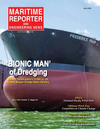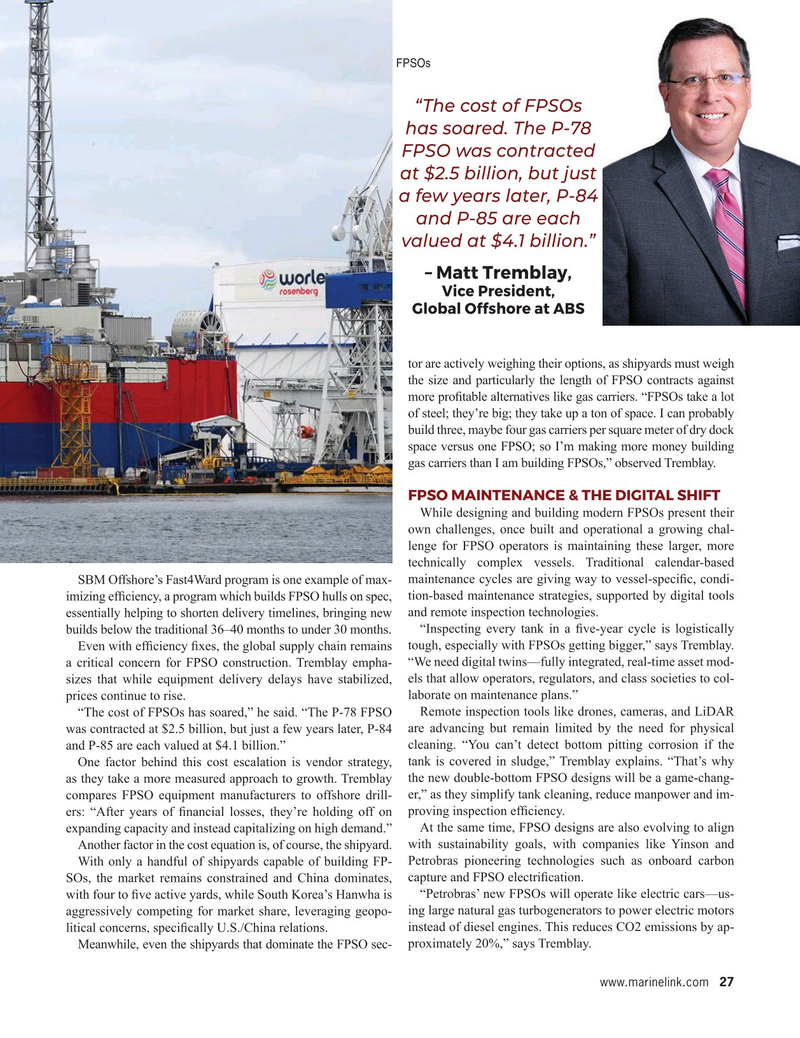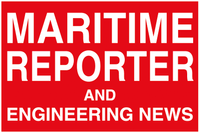
Page 27: of Maritime Reporter Magazine (April 2025)
Read this page in Pdf, Flash or Html5 edition of April 2025 Maritime Reporter Magazine
FPSOs “The cost of FPSOs has soared. The P-78
FPSO was contracted at $2.5 billion, but just a few years later, P-84 and P-85 are each valued at $4.1 billion.” – Matt Tremblay,
Vice President,
Global Offshore at ABS tor are actively weighing their options, as shipyards must weigh the size and particularly the length of FPSO contracts against more pro? table alternatives like gas carriers. “FPSOs take a lot of steel; they’re big; they take up a ton of space. I can probably build three, maybe four gas carriers per square meter of dry dock space versus one FPSO; so I’m making more money building gas carriers than I am building FPSOs,” observed Tremblay.
FPSO MAINTENANCE & THE DIGITAL SHIFT
While designing and building modern FPSOs present their own challenges, once built and operational a growing chal- lenge for FPSO operators is maintaining these larger, more technically complex vessels. Traditional calendar-based
SBM Offshore’s Fast4Ward program is one example of max- maintenance cycles are giving way to vessel-speci? c, condi- imizing ef? ciency, a program which builds FPSO hulls on spec, tion-based maintenance strategies, supported by digital tools essentially helping to shorten delivery timelines, bringing new and remote inspection technologies.
builds below the traditional 36–40 months to under 30 months. “Inspecting every tank in a ? ve-year cycle is logistically
Even with ef? ciency ? xes, the global supply chain remains tough, especially with FPSOs getting bigger,” says Tremblay. a critical concern for FPSO construction. Tremblay empha- “We need digital twins—fully integrated, real-time asset mod- sizes that while equipment delivery delays have stabilized, els that allow operators, regulators, and class societies to col- prices continue to rise. laborate on maintenance plans.” “The cost of FPSOs has soared,” he said. “The P-78 FPSO Remote inspection tools like drones, cameras, and LiDAR was contracted at $2.5 billion, but just a few years later, P-84 are advancing but remain limited by the need for physical and P-85 are each valued at $4.1 billion.” cleaning. “You can’t detect bottom pitting corrosion if the
One factor behind this cost escalation is vendor strategy, tank is covered in sludge,” Tremblay explains. “That’s why as they take a more measured approach to growth. Tremblay the new double-bottom FPSO designs will be a game-chang- compares FPSO equipment manufacturers to offshore drill- er,” as they simplify tank cleaning, reduce manpower and im- ers: “After years of ? nancial losses, they’re holding off on proving inspection ef? ciency.
expanding capacity and instead capitalizing on high demand.” At the same time, FPSO designs are also evolving to align
Another factor in the cost equation is, of course, the shipyard. with sustainability goals, with companies like Yinson and
With only a handful of shipyards capable of building FP- Petrobras pioneering technologies such as onboard carbon
SOs, the market remains constrained and China dominates, capture and FPSO electri? cation.
with four to ? ve active yards, while South Korea’s Hanwha is “Petrobras’ new FPSOs will operate like electric cars—us- aggressively competing for market share, leveraging geopo- ing large natural gas turbogenerators to power electric motors litical concerns, speci? cally U.S./China relations. instead of diesel engines. This reduces CO2 emissions by ap-
Meanwhile, even the shipyards that dominate the FPSO sec- proximately 20%,” says Tremblay.
www.marinelink.com 27
MR #4 (18-33).indd 27 4/2/2025 9:00:53 AM

 26
26

 28
28
